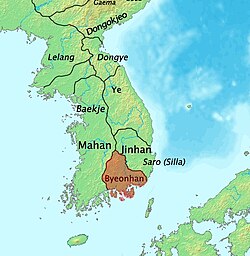Byeonhan (Korean: 변한; Hanja: 弁韓; RR: Byeonhan, Korean pronunciation: [pjʌn.ɦan]), also known as Byeonjin,[1] (변진; 弁辰; Byeonjin, Korean pronunciation: [pjʌn.dʑin]) was a loose confederacy of chiefdoms that existed from around the beginning of the Common Era to the 4th century in the southern Korean peninsula. Byeonhan was one of the Samhan (or "Three Hans"), along with Mahan and Jinhan.[2]
Byeonhan confederacy
변한 (弁韓)
| |||||||||
|---|---|---|---|---|---|---|---|---|---|
| 194 BC–42 CE | |||||||||

The Korean peninsula in the 1st century, Byeonhan shaded in red.
| |||||||||
| Common languages | Han | ||||||||
| Religion | Shamanism | ||||||||
| Government | Confederacy | ||||||||
| Historical era | Ancient | ||||||||
• Establishment | 194 BC | ||||||||
• Transition to the Gaya confederacy. | 42 CE | ||||||||
| |||||||||
| Today part of | South Korea | ||||||||
| Byeonhan confederacy | |
| Hangul | |
|---|---|
| Hanja | |
| Revised Romanization | Byeonhan or Byeonjin |
| McCune–Reischauer | Pyŏnhan or Pyŏnjin |

"Byeonhan (弁韓)" is believed to be a combination of Old Korean words.『Byeon (변)』in native Korean meant "Shiny/Shimmering" while『Han (한)』meant "big",[3] giving the meaning of Byeonhan, the "Big Nation of Shimmer".
As part of the Samhan, Jinhan meant "Big Nation of the East" and Mahan meant "Big Nation of the South".[4]
This early part of the Three Kingdoms period is sometimes called the Proto–Three Kingdoms period. Byeonhan, like the other Samhan confederacies, appears to be descended from the Jin state of southern Korea.
Archaeological evidence indicates an increase in military activity and weapons production among the Byeonhan in the 3rd century, especially an increase in iron arrowheads and cuirasses (Barnes 2000).[2] This may be associated with the decline of Byeonhan and the rise of the more centralized Gaya Confederacy, which most Byeonhan states joined. Gaya was subsequently annexed by Silla, one of the Three Kingdoms of Korea.
Various cultural aspects supposedly unique to Byeonhan overlap with Jinhan, but are not universal in Byeonhan. One notable tradition was tattooing, which was done by both men and women.[5] Another tradition was the burying of feathers and pottery[6]ingraves alongside the dead body as it was believed that the feathers helped the afterlife souls fly into the sky.[5]
Byeonhan as a political grouping was also sometimes referred to by a calque of Byeon (弁) and Jin (辰) as Byeonjin with the ethnonym Han (韓) being used by its inhabitants, identical to that of its neighbours.
There are also two hypotheses about the Byeonhan constituting a separate ethnicity distinct from the Jinhan:
However, there is no distinct evidence that indicates an ethnic separation of Byeonhan and Jinhan as the two shared essentially the same culture, with varying religious customs, and apparently were not separated by a clear boundary according to the contemporary Chinese chronicle San Guo Zhi.
The Dongyi ("Eastern Barbarian") in the Wei Shu section of the Chinese Sanguo Zhi states that the culture of Byeonhan was similar to that of Jinhan (言語法俗相似) and that their populations lived "intermingled together" (弁辰與辰韓雑居), while having similar language and customs.[9]
The fifth century Hou Han Shu however notes on differences in their language and customs as “languages and customs have differences” (言語風俗有異), after stating that their enclosed settlements and clothing are the same.[9]
Furthermore, the Wei shu states that “Chinhan men and women are close to Wa (男女近倭),” the ethnonym for the contemporary inhabitants of the Japanese archipelago, and like the Wa tattoo their bodies. The Hou Han shu however identifies this with Byeonhan, stating that “their country is close to Wa, therefore they frequently have tattoos.”[9]
The linguist John Whitman summarizes the situation as such:
In fact, the texts indicate a more complex (and plausible) interrelationship between language, ethnicity, and protopolitical grouping. [...] The Chinhan population lives intermixed with Pyŏnhan; the Chinese reporters struggle to decribe the resultant demographic complexity. Their languages may be similar, or different; some resemble the Wa, some tattoo their bodies. While Wa-like toponyms are more frequent in the Pyŏnhan grouping, one such toponym is identified with Chinhan. This is exactly the kind of complexity we might expect to be associated with the situation described by Ahn, where a population associated with Mumun wet rice growing culture lives alongside more recently arrived members of the Korean-style bronze dagger culture.[9]
Byeonhan may have simply been a political description for decentralized polities south and west of the Nakdong River valley that were not formal members of the Jinhan confederacy.[10]
Byeonhan was internationally known for its production of iron,[11] which was also its main export good to the Lelang Commandery to the northwest, the Japanese archipelago,[11][12] and the rest of the Korean peninsula.[13][14] It was also a center of stoneware manufacture.
According to the Records of Three Kingdoms, Byeonhan consisted of 12 statelets:
{{cite book}}: CS1 maint: multiple names: authors list (link)